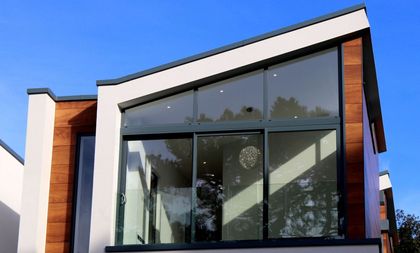Just How Residential Window Tinting Improves Your Home's Power Efficiency
Residential home window tinting presents a compelling option for homeowners seeking to improve power performance within their living spaces. By applying specialized films to home windows, it properly reduces warm transfer, consequently maintaining interior temperatures and lessening the demand for too much home heating or cooling.
Comprehending Home Window Tinting
Recognizing home window tinting is important for house owners looking for to boost both convenience and power performance in their space. Residential Window Tint. Home window tinting involves the application of a slim movie to the interior or exterior surface of glass home windows. This movie can significantly modulate the quantity of sunlight and warm that goes into a home, hence affecting interior environment conditions
There are different kinds of window tinting films available, each with distinct properties. The performance of window tinting is frequently determined by its Visible Light Transmission (VLT) percentage, which suggests just how much light can pass through the film.
Benefits of Energy Effectiveness
Window tinting not only enhances looks however likewise plays a considerable duty in boosting energy effectiveness within residential areas. By minimizing warm transfer with home windows, tinted films create a much more secure interior environment, which can cause substantial reductions in power consumption for cooling and heating. This energy effectiveness translates right into reduced utility bills, offering property owners with substantial long-lasting financial savings.

Furthermore, window tinting boosts the comfort of living spaces. By minimizing glow and blocking hazardous UV rays, tinted windows develop an even more enjoyable setting, which can cause boosted wellness for passengers. The security against UV rays additionally aids protect furniture and floor covering from fading, adding to the long life of family products.
Exactly How Tinting Functions
Tinting films run through a mix of innovative products and innovations designed to control the quantity of solar power getting in a home. Primarily made up of polyester, these films frequently include metallic or ceramic fragments that absorb and reflect warm. This dual capacity allows them to considerably minimize the penetration of ultraviolet (UV) rays and infrared radiation while allowing noticeable light to go through.
The effectiveness of window tinting is measured by its solar warmth gain coefficient (SHGC), which indicates how much solar power is transmitted with the window. Reduced SHGC worths are more effective as they represent higher warmth being rejected. In addition, window colors can include a range of shades, permitting home owners to personalize their visual choices while improving energy performance.
Moreover, these films work as an obstacle, avoiding warm loss throughout colder months by mirroring indoor warmth back into the space. This visit their website thermal insulation effect enhances the air conditioning benefits gained throughout warmer months, adding to a well balanced indoor climate year-round. By handling solar power successfully, property window tinting not only enhances convenience but additionally plays a crucial function in minimizing power usage and lowering energy costs.
Choosing the Right Tint

There are various types of window movies available, including dyed, metalized, and ceramic. Ceramic movies offer exceptional warm control without endangering Look At This visibility and are very resilient, making them a popular choice.
Visible light transmission (VLT) is another crucial factor, as it shows the amount of all-natural light that can travel through the tinted glass. House owners should select a tint with a VLT that complements their lights choices while still giving adequate glare reduction.
Furthermore, evaluating the solar heat gain coefficient (SHGC) can assist establish exactly how well a color can obstruct warmth from sunlight. A lower SHGC here shows far better heat control, inevitably boosting energy performance.
Setup and Maintenance Tips
Correct installment and maintenance are important parts in taking full advantage of the advantages of residential window tinting. Experts likewise make use of specialized tools and strategies, which can enhance the longevity and effectiveness of the color.
Complying with installment, upkeep is essential to prolong the life of the window movie. It is recommended to wait at least 30 days before cleaning up the tinted windows to enable the glue to heal fully.
Addressing these issues immediately can stop additional damages and preserve power efficiency. By sticking to these installation and upkeep ideas, house owners can guarantee their home window tinting proceeds to provide substantial energy financial savings and comfort for years to come.
Conclusion
To conclude, residential home window tinting acts as an effective service for improving power effectiveness within homes. By minimizing heat transfer and blocking damaging UV rays, window movies add to decrease energy consumption and boosted indoor convenience. The selection of appropriate tinting products, together with appropriate installation and upkeep, better maximizes these benefits. Eventually, home window tinting stands for a sustainable investment that not just lowers energy costs but also promotes a comfortable living atmosphere throughout the year.
Window tinting involves the application of a slim film to the interior or outside surface area of glass home windows. By lowering heat transfer via windows, colored films produce an extra secure indoor climate, which can lead to considerable decreases in power consumption for home heating and cooling.The performance of window tinting is measured by its solar warm gain coefficient (SHGC), which suggests exactly how much solar power is transferred via the window. By handling solar power efficiently, property home window tinting not just boosts comfort but additionally plays a crucial duty in reducing power intake and decreasing energy expenses.
By decreasing warmth transfer and obstructing harmful UV rays, home window movies contribute to lower power intake and improved interior convenience.